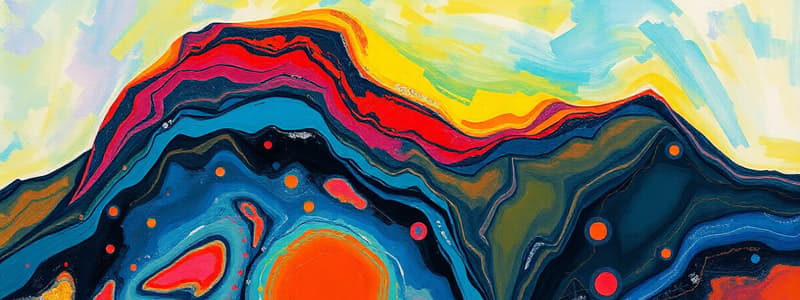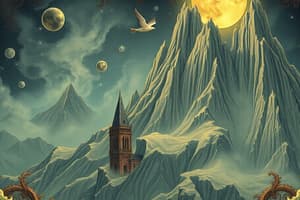Podcast
Questions and Answers
What is the lithosphere primarily composed of?
What is the lithosphere primarily composed of?
- Solid rock (correct)
- Weak and soft minerals
- Liquid magma
- Metamorphic layers
Which layer beneath the lithosphere is characterized as a soft, weak zone?
Which layer beneath the lithosphere is characterized as a soft, weak zone?
- Asthenosphere (correct)
- Core
- Crust
- Mantle
Where do most earthquakes occur on Earth?
Where do most earthquakes occur on Earth?
- In the polar regions
- Along ocean trenches and continental edges (correct)
- At the tops of mountains
- In the center of continents
What primarily constitutes the surface along which most slip occurs during an earthquake?
What primarily constitutes the surface along which most slip occurs during an earthquake?
What geological feature is associated with a high frequency of earthquakes?
What geological feature is associated with a high frequency of earthquakes?
What is a common consequence of large earthquakes near ocean trenches?
What is a common consequence of large earthquakes near ocean trenches?
In which fault type did the 1983 Borah Peak earthquake occur?
In which fault type did the 1983 Borah Peak earthquake occur?
What was the magnitude of the Hebgen Lake earthquake in 1959?
What was the magnitude of the Hebgen Lake earthquake in 1959?
Which term refers to processes that deform the crust and mantle?
Which term refers to processes that deform the crust and mantle?
Which of the following formations is made by the movement along a fault?
Which of the following formations is made by the movement along a fault?
What was one consequence of the Tohoku earthquake in 2011?
What was one consequence of the Tohoku earthquake in 2011?
Which of the following statements about fault scarps is true?
Which of the following statements about fault scarps is true?
Which areas are noted for having abundant earthquakes?
Which areas are noted for having abundant earthquakes?
What is the main role of geophysical instruments in earthquake studies?
What is the main role of geophysical instruments in earthquake studies?
What does the term 'asthenosphere' mean?
What does the term 'asthenosphere' mean?
Where was the epicenter of the 2011 Tohoku earthquake located?
Where was the epicenter of the 2011 Tohoku earthquake located?
How deep was the main hypocenter of the Tohoku earthquake?
How deep was the main hypocenter of the Tohoku earthquake?
What characterizes the East California Shear Zone?
What characterizes the East California Shear Zone?
How do earthquake waves travel through rocks?
How do earthquake waves travel through rocks?
What natural disaster was triggered by the Tohoku earthquake?
What natural disaster was triggered by the Tohoku earthquake?
Which city was notably affected by the 2010 Haiti earthquake?
Which city was notably affected by the 2010 Haiti earthquake?
What does the term 'seismic' derive from?
What does the term 'seismic' derive from?
What type of fault was involved in the Hebgen Lake earthquake?
What type of fault was involved in the Hebgen Lake earthquake?
Which of the following describes the economic impact of the Tohoku earthquake?
Which of the following describes the economic impact of the Tohoku earthquake?
What event is described as the most severe and destructive earthquake experienced in the Philippines during the last 20 years as of 1968?
What event is described as the most severe and destructive earthquake experienced in the Philippines during the last 20 years as of 1968?
What was the intensity of the Casiguran Earthquake according to the Rossi-Forel Intensity Scale?
What was the intensity of the Casiguran Earthquake according to the Rossi-Forel Intensity Scale?
What geological process is happening at the plate boundary involving the Indian-Australian plate?
What geological process is happening at the plate boundary involving the Indian-Australian plate?
What happens to a seismic wave when it passes from a slower material to a faster one?
What happens to a seismic wave when it passes from a slower material to a faster one?
What does the Engineering Geology and GeoHazard Assessment process require from land development project proponents?
What does the Engineering Geology and GeoHazard Assessment process require from land development project proponents?
Which building collapsed instantly during the Casiguran Earthquake?
Which building collapsed instantly during the Casiguran Earthquake?
What type of earthquake-related damage was sustained by several major buildings near Binondo and Escolta in Manila?
What type of earthquake-related damage was sustained by several major buildings near Binondo and Escolta in Manila?
What is the purpose of the DENR AO2000-28 issued by the Philippine government?
What is the purpose of the DENR AO2000-28 issued by the Philippine government?
What effect can liquefaction have on structures built over it?
What effect can liquefaction have on structures built over it?
Which of these is NOT a common effect of landslides triggered by earthquakes?
Which of these is NOT a common effect of landslides triggered by earthquakes?
What type of earthquake hazard is characterized by a series of waves caused by seismic activity under the sea?
What type of earthquake hazard is characterized by a series of waves caused by seismic activity under the sea?
How does soft ground affect earthquake vibrations?
How does soft ground affect earthquake vibrations?
Which construction technique is most likely to protect buildings from earthquake damage?
Which construction technique is most likely to protect buildings from earthquake damage?
What is the primary characteristic of resonance frequency in buildings?
What is the primary characteristic of resonance frequency in buildings?
What is a common cause of damage in tall buildings during an earthquake?
What is a common cause of damage in tall buildings during an earthquake?
Which factor contributes to better survival rates in buildings during earthquakes?
Which factor contributes to better survival rates in buildings during earthquakes?
Study Notes
Earth's Layers and Tectonics
- The lithosphere, meaning "stone" in Greek, is a rigid layer formed by the upper mantle and crust.
- The asthenosphere is a soft, weak zone beneath the lithosphere, with a thickness of approximately 80 to 150 km, reaching depths of about 250 km.
Earthquake Distribution
- Earthquakes are concentrated in specific belts, particularly along the western coasts of North and South America and mid-ocean ridges.
- Regions like the Middle East, China, and Tibet experience abundant earthquakes, while many continental interiors are relatively quiet.
- Areas with narrow continental shelves see more earthquakes, while wider shelves, like the eastern coasts of the Americas, experience fewer.
- Ocean trenches and island arcs are characterized by a high frequency of earthquakes, often linked to the largest and most destructive events.
Notable Earthquake Events
- The 2011 Tohoku earthquake in Japan had a magnitude of 9.0, one of the largest ever recorded, resulting in over 24,000 casualties and extensive damage exceeding $300 billion.
- The 2010 Haiti earthquake, magnitude 7.0, occurred near Port-au-Prince, causing significant devastation due to its proximity to an active fault line.
- The 1959 Hebgen Lake earthquake (magnitude 7.3) resulted in the formation of Earthquake Lake in Montana due to massive ground movement.
Seismic Waves
- Seismic waves, generated by earthquakes, travel through rocks and are studied by seismologists using geophysical instruments for data on their patterns and origins.
- The rupture area can significantly affect the characteristics of seismic waves during an earthquake, which may differ based on materials they pass through.
Earthquake Hazards
- Liquefaction occurs when saturated sediments behave like liquids, leading to potential sinking or tilting of structures.
- Landslides can result from strong shaking, causing erosion and blockage of infrastructure.
- Tsunamis are series of waves triggered by underwater earthquakes, leading to flooding and coastal damage.
Civil Engineering Considerations
- Soft ground amplifies earthquake vibrations, increasing structural vulnerability, while harder rocks mitigate shaking effects.
- Effective building design and materials are crucial; lightweight materials and proper construction techniques enhance survival rates during seismic events.
- Resonance frequency, influenced by building height, can lead to increased damage; tall buildings may sustain more damage at lower frequencies.
Ground Conditions and Building Design
- Structures built on flood plains or reclaimed land are more susceptible to damage due to amplified vibrations.
- Poor construction practices, like inadequate tying of slab walls and floors, increase the risk of structural failure during earthquakes.
- Buildings constructed with high-quality materials and proper bracing generally fare better in seismic events.
Studying That Suits You
Use AI to generate personalized quizzes and flashcards to suit your learning preferences.
Description
This quiz explores the characteristics and functions of the lithosphere and asthenosphere. Discover how these layers of the Earth's structure interact and their significance in geological processes. Test your understanding of these fundamental concepts in geology.




